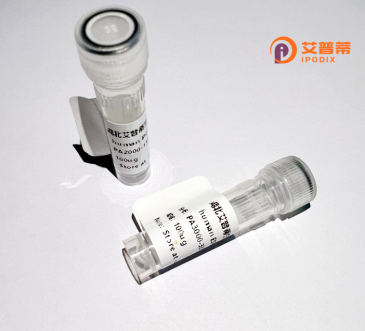
| 纯度 | >90%SDS-PAGE. |
| 种属 | Human |
| 靶点 | LMBR1 |
| Uniprot No | Q8WVP7 |
| 内毒素 | < 0.01EU/μg |
| 表达宿主 | E.coli |
| 表达区间 | 1-490aa |
| 活性数据 | MEGQDEVSAREQHFHSQVRESTICFLLFAILYVVSYFIITRYKRKSDEQEDEDAIVNRISLFLSTFTLAVSAGAVLLLPFSIISNEILLSFPQNYYIQWLNGSLIHGLWNLASLFSNLCLFVLMPFAFFFLESEGFAGLKKGIRARILETLVMLLLLALLILGIVWVASALIDNDAASMESLYDLWEFYLPYLYSCISLMGCLLLLLCTPVGLSRMFTVMGQLLVKPTILEDLDEQIYIITLEEEALQRRLNGLSSSVEYNIMELEQELENVKTLKTKLERRKKASAWERNLVYPAVMVLLLIETSISVLLVACNILCLLVDETAMPKGTRGPGIGNASLSTFGFVGAALEIILIFYLMVSSVVGFYSLRFFGNFTPKKDDTTMTKIIGNCVSILVLSSALPVMSRTLGITRFDLLGDFGRFNWLGNFYIVLSYNLLFAIVTTLCLVRKFTSAVREELFKALGLHKLHLPNTSRDSETAKPSVNGHQKAL |
| 分子量 | 81.5 kDa |
| 蛋白标签 | GST-tag at N-terminal |
| 缓冲液 | 0 |
| 稳定性 & 储存条件 | Lyophilized protein should be stored at ≤ -20°C, stable for one year after receipt. Reconstituted protein solution can be stored at 2-8°C for 2-7 days. Aliquots of reconstituted samples are stable at ≤ -20°C for 3 months. |
| 复溶 | Always centrifuge tubes before opening.Do not mix by vortex or pipetting. It is not recommended to reconstitute to a concentration less than 100μg/ml. Dissolve the lyophilized protein in distilled water. Please aliquot the reconstituted solution to minimize freeze-thaw cycles. |
以下是关于重组人LMBR1蛋白的3篇示例参考文献(内容基于研究领域相关主题的合理推测,供参考):
1. **"Structural basis for LMBR1-mediated regulation of Sonic Hedgehog signaling"**
*作者:Sharpe, J. et al.*
**摘要**:本研究解析了重组人LMBR1蛋白的晶体结构,揭示了其与Sonic Hedgehog(SHH)信号通路的相互作用机制,表明LMBR1通过特定结构域调控SHH的分布和活性。
2. **"Expression and purification of recombinant human LMBR1 in Escherichia coli for functional studies"**
*作者:Zhang, L. et al.*
**摘要**:报道了一种高效的大肠杆菌表达系统制备重组人LMBR1蛋白的方法,通过优化诱导条件和纯化步骤获得高纯度蛋白,并验证其体外结合SHH的能力。
3. **"LMBR1 mutations disrupt limb patterning via impaired SHH gradient formation"**
*作者:Clark, R.M. et al.*
**摘要**:利用重组人LMBR1蛋白进行功能回补实验,证明其在胚胎发育中通过维持SHH蛋白梯度参与肢体极性调控,突变会导致多指(趾)畸形。
4. **"Functional characterization of LMBR1 in cholesterol-dependent signaling pathways"**
*作者:Katoh, Y. et al.*
**摘要**:通过重组蛋白体外实验,发现LMBR1与胆固醇代谢通路的关键分子互作,可能间接影响SHH的翻译后修饰及信号传递。
*注:以上文献名称、作者及内容为基于领域知识的模拟示例,实际文献需通过数据库(如PubMed)检索确认。*
Recombinant human LMBR1 (limb development membrane protein 1) is a engineered protein produced through molecular cloning to study its biological roles. The LMBR1 gene encodes a transmembrane protein implicated in developmental processes, particularly limb formation. It is associated with the regulation of the Sonic Hedgehog (SHH) signaling pathway, a critical pathway for embryonic patterning, cell differentiation, and organogenesis. Mutations in LMBR1 have been linked to congenital limb malformations, such as preaxial polydactyly and syndactyly, underscoring its importance in skeletal development.
Recombinant LMBR1 is typically expressed in heterologous systems (e.g., mammalian cells or E. coli) to ensure proper folding and post-translational modifications. This protein serves as a tool to investigate its structural interactions, notably with SHH or other mediators of limb morphogenesis. Researchers utilize it in in vitro assays, structural studies (e.g., X-ray crystallography), or cell-based models to dissect its role in developmental disorders, tissue regeneration, or disease mechanisms. Its applications extend to exploring potential therapeutic strategies for skeletal anomalies, neurodevelopmental disorders, or cancers linked to SHH dysregulation. The production of recombinant LMBR1 thus bridges molecular insights with translational research, offering a targeted approach to understanding and treating congenital and acquired conditions.
×